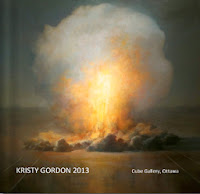I've decided to do a new post about my current palette, as looking back on my last post about my palette, I've realized how much my palette has changed since then. It was fun to read my 2008 post, I had sch a cute, informal way of writing back then that I feel like I would never allow myself to post now. A lot of what I wrote still stands, my full palette is basically a combination of the artists I have studied with, and has transformed over the years. At this point it's a combination of Jeremy Lipking, Juan Martinez and Yuqi Wang, with a little Kristy Gordon mixed in there as well. I've taken a lot of the earth reds and browns off my palette now, which forces me to mix from brighter pigments and create richer colors.
I mix certain colors out to a "string" to create a tonal range to work from. To do this I use a palette knife and pull the color down to some white, mix it in and back up, creating a darkest, middle and light tone for certain colors. I am careful to leave the color at the back pure, with no white mixed in. Also, I don't do this with the transparent colours anymore, such as transparent red oxide, viridian and ultramarine, as mixing white in with these colors would make them more opaque. Therefore, I keep white far away from them since I want to keep them as transparent as possible. I also prefer certain brands for the transparent colors, both Richeson and Windsor Newton have the most transparent versions I have found of transparent red oxide, burnt sienna, viridian and ultramarine blue. I like to have transparency in my shadows, so by avoiding mixing white in and using transparent brands for the transparent colors, I am able to get the shadows to set back into transparent paint.
Another amazing thing I have discovered is something I learned from Alexandra Tyng, where cadmiums, which are usually somewhat opaque, when mixed together with a transparent compliment, become quite transparent. So when I teach workshops with a full palette, I have the participants mix these two separate shadow color mixtures: cadmium red light with viridian green, and cadmium orange with ultramarine blue. These provide the lovely rich shadow colors that I prefer over using the browns and earth reds that I would reach for if I still had them on my palette.
I have also developed a series of pre-mixed colors that I always have on my palette. I even find the "flesh color" useful when I'm painting plein air landscapes! The "flesh color" is a base color that I tint to make it cooler or warmer as needed to match the color of the models skin. The "blue mixture" is one that I learned from Jeremy Lipking. It's a compliment to the flesh color (blue compliments orange) so when I want to make the flesh cooler, but not darken it as adding ultramarine blue to it would, this works well. It's already lightened to the tone of the flesh color. I started mixing the neutral grey mixture as well. I'm not sure when it started, it just happened very naturally, and it's a very useful color for me to have handy.
I hope that helps! Feel free to post comments and questions below!








2 comments:
This is very interesting, Kristy. For about 10 months I have been taking a weekly portrait painting class with an instructor. He trains with the Daniel Greene palette...lots of earth tones. If you have time please share why you did away with earth tones . Thanks Nina Young
Nina Says: Did not realize I had signed up for your blog through my husband's email. Sorry to be somewhat confusing. I see my husband's face up there. LOL.
Post a Comment